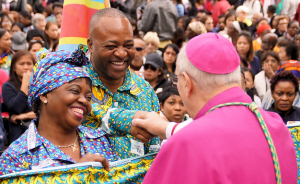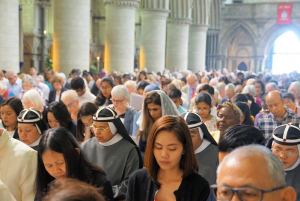 The Cathedral Church is the Mother Church of the Diocese of East Anglia [www.rcdea.org.uk], and the parish church of central and south-west Norwich. We are open daily [7.30am – 6.30pm], and welcome all visitors.
The Cathedral Church is the Mother Church of the Diocese of East Anglia [www.rcdea.org.uk], and the parish church of central and south-west Norwich. We are open daily [7.30am – 6.30pm], and welcome all visitors.
A Cathedral is the seat of the local bishop, who is the successor of the Apostles, and the guarantor of our Catholic communion with the Church. His chair, or cathedra, sits in our sanctuary, and from there, and from the sacred altar, he presides over the local church of East Anglia, by the grace of God, and by appointment of the Apostolic See.
At the heart of every Catholic Church is the altar, upon which Christ’s disciples continue place bread and wine in memory of him. Through the sacred liturgical prayer of the Mass, the priest confects the eucharist, the Body and Blood of Christ, which is the salvation of all persons, and the source and summit of the Christian life. Any church building, whether humble or grand, is built to house this action: it is the primary and most important function of the Cathedral. In fact, all other functions and activities flow from that reality.
Our own Cathedral Church was completed only in 1910, and designed by George Gilbert Scott, junior, in a particularly fine example of the gothic revival style which was popular at the time in this country. It was not built, in fact, as a cathedral, but as the parish church of Norwich, replacing two earlier and smaller sites in the city centre. It was the generous gift to the Catholics of Norwich of Henry, Duke of Norfolk, as a thank-offering for his first marriage to Lady Flora Abney-Hastings. The Duke, following an approach by Canon Richard Duckett, the parish priest of Norwich at the time, commissioned the building and took a keen interest in every aspect of its design from its initial conception in the early 1870s to its completion and dedication in 1910. The church building was solemnly consecrated, however, only in 1957. It remained a simple parish church until 1976, when by command of Pope St Paul VI, it became the cathedral of a newly revived Diocese of East Anglia. It is the second largest Catholic Cathedral in the country.

Our patron saint, St John the Baptist, was the forerunner of Christ, who announced the coming of Jesus, and who brought his first disciples to him. This is the vocation of every Christian, and of every parish: to make Christ visible. The adoption of our patron saint is fortuitous. The 18th century parish church sat behind the mediaeval church of St John the Baptist at Maddermarket, in Norwich. The name was brought from this historic site to our new location.
The Cathedral of St John the Baptist is one of Norwich’s iconic buildings, rising above the city skyline. It was built by the humble craftsmen of our city. Its external grandeur and magnificent interior, especially the fine stonework and beautiful stained glass make it well worth a visit, not only as a place of historical or architectural interest, but, most of all, as a place of prayer. For in this place, Jesus awaits with love all those who seek to encounter him.




